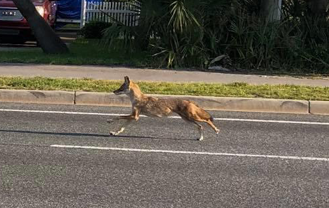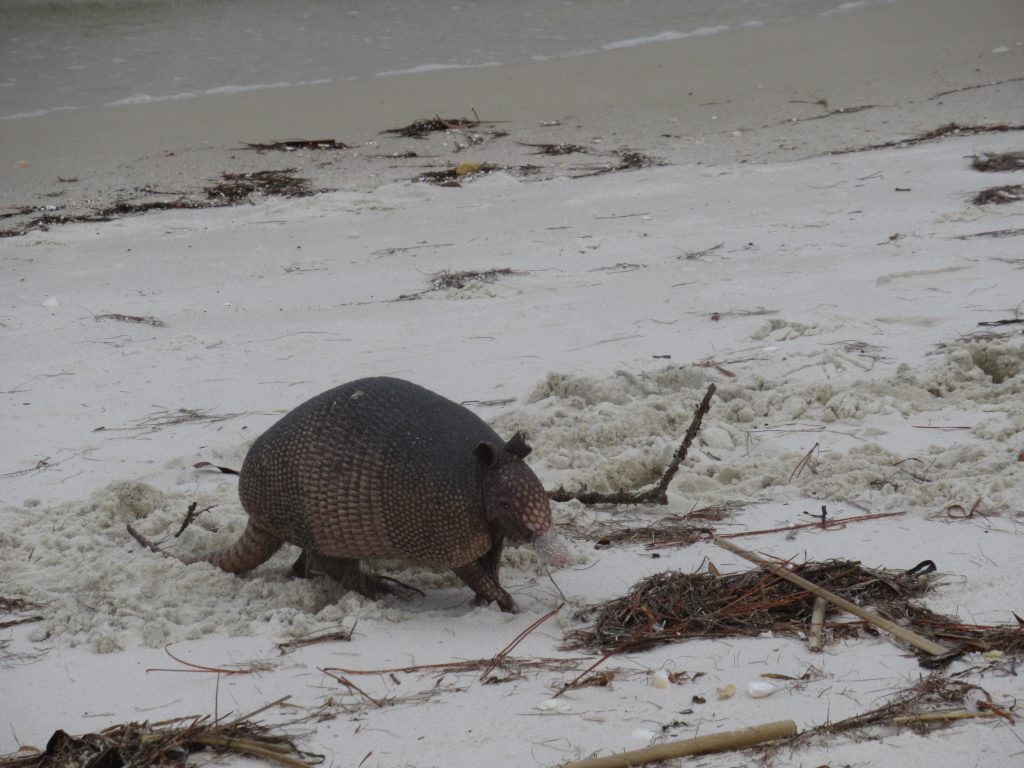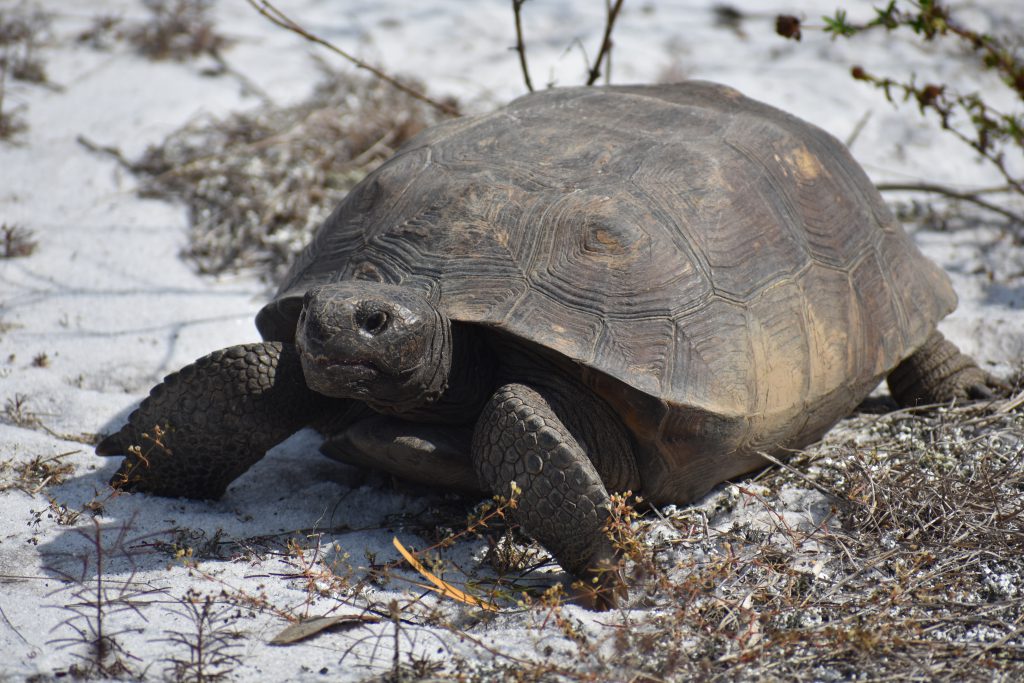From coyotes to gopher tortoises and beach mice, many animals make their home on Florida’s barrier islands. Humans helped draw animals to these fragile habitats. Now, we’re squeezing them out.
When crossing the Bob Sikes Bridge from Gulf Breeze to Santa Rosa Island in Florida’s western Panhandle, the last thing you’d probably expect to see is a coyote trotting across the bridge. But it’s more common than you’d think. Coyotes have settled on Santa Rosa and several other barrier islands in Florida, some crossing the bridges back and forth in search of food — or perhaps out of curiosity about what they’ll find on the other end.
Coyotes’ appearance on Florida’s barrier islands probably involved more than bridges; they are known to be good swimmers. But their expansion onto Santa Rosa and other islands reveals the surprising range of wildlife on Florida’s barrier islands — both wild islands and those inhabited by humans.

Barrier islands are home to all manner of animals: From more-common raccoons and armadillos, to threatened species like gopher tortoises and snowy plovers, to endangered species endemic to their islands, like Key deer or the secretive Perdido Key beach mouse.
Many of these animal islanders take great care to keep out of sight of humans, even disrupting their natural circadian rhythms to do so. Even animals that aren’t nocturnal will avoid being out in the open during daylight hours when humans are around. Come morning, the crisscross of animal tracks along the sandy beaches or muddy estuaries are tell-tale signs that wild animals have been through.
Yet with hundreds of thousands of people squeezed onto or visiting Florida’s barrier islands, humans are hard to avoid. Rising human population, tourism and development — along with the mounting harm of climate change to animal habitats — mean human-wildlife encounters on barrier islands are also increasing. Too often, they are increasingly deadly for animals.
How animals make their way to barrier islands
Raccoons and armadillos are among the species other than coyotes that have been seen using human bridges to reach barrier islands. Some raccoons also were purposefully let loose on islands by people who trapped them to get rid of them somewhere else, says Capt. Kenny McCain of Cedar Key, who worked for many years as a wildlife officer on the islands of the Cedar Keys National Wildlife Refuge.
With other species, how they got there is more up for debate. But there are plenty of theories. Long-established animals such as beach mice and gopher tortoises could have walked to islands thousands of years ago, when some islands were still connected to the mainland by sand spits, says Escambia County Sea Grant extension agent Rick O’Connor.
Many animals also could have come by water. While gopher tortoises are not good swimmers, biological scientist Travis Thomas at the University of Florida’s Nature Coast Biological Station says they are “great floaters.” As absurd as it sounds, some tortoises could have landed on a barrier island by pure chance by riding a current.

Once settled and separated from the rest of their population, some barrier island animals evolved into subspecies. Beach mice are a prime example. Eight subspecies — five on the Gulf Coast and three on the Atlantic — have evolved from the Southeastern beach mouse. The Perdido Key Beach Mouse has been listed as critically endangered due to threats that include continued development of its sand dune habitat.
Another subspecies, the Santa Rosa Beach Mouse, is better off than its Perdido Key cousin but still faces human pressures including feral cats, which scientists say cause high mortality to the small, gray mice.
Endangered islanders
To help protect the Perdido Key Beach Mouse, much of what islanders can and can’t do on their homesites is dictated by whether it will negatively impact the species. Any landscape changes on land deemed mouse habitat have to be approved by the county, even in someone’s own backyard. Restrictions include removing or adding new plants, putting in lawns, or cutting grass short.
Plenty of residents are fine with the island’s famed mouse until it affects them; they’ll start work on a project only to realize they can’t finish because of a tiny mouse.
Protections for the mice can also make it hard to keep nuisance species away. O’Connor describes a time he tried to advise a community dealing with cottonmouth snakes. He suggested “cutting a buffer between overgrown empty lots and their house” since snakes tend to avoid short grass. However, the solution was off the table because of the beach mice. Other solutions, such as placing snake-attracting fish carcasses and bird feeders far away from personal property, have helped islanders strike a balance between helping the endangered mice and keeping away the less-endearing snakes.
Other vulnerable species including gopher tortoises are having a harder time surviving human neighbors. These gentle reptiles are considered a keystone species because the burrows they dig provide protection to more than 300 other species.
The population of gopher tortoises on barrier islands has taken a significant hit, mostly due to humans. “It is literally extermination,” O’Connor says. Tortoises like high and dry, sandy soils —– just the kind people like to build on. Human construction forces them from their homes. They often struggle to find a new habitat that meets all their needs. They can starve to death if they are unable to find a new, suitable place to live.
Making it even worse for gopher tortoises on barrier islands is the competition for space. “Oftentimes, tortoises are kind of an afterthought,” Thomas says.
Hurricanes, which have become stronger as climate change warms ocean waters, can also flatten gopher tortoises’ sand-dune homes, not unlike storms can wipe out a human neighborhood. With their burrow destroyed by a hurricane, tortoises will most likely abandon their digs in search of a new burrow at a higher elevation, according to a study by Barbara Blonder, Kyra Liedtke and Sloane Stephens.
Relocating tortoises back to the mainland also raises problems for them. Having been isolated from the rest of the population, they face higher risk of disease. Gopher tortoises are especially vulnerable to upper respiratory tract disease, fatal for them most of the time. Thomas says that this disease tends to ravage populations under stress.

As for the problem of feral cats, O’Connor says that many of them actually belong to people who treat them as outdoor cats and just let them roam around. But the story is even worse than that. O’Connor adds that some mainlanders bring their cats to barrier islands to let them go and abandon them.
Feral cats are regarded as invasive species because they kill so much local wildlife; not only the little beach mice, but also many birds, amphibians and reptiles such as lizards and skinks. Limited space on islands can aggravate the feral cat problem, especially when local wildlife are without predators. Domesticated cats are implicated in numerous animal extinctions, animal scientist Susanna Kitts-Morgan has found, including contributing to global extinctions of some bird species on islands.
Living ethically with animal neighbors
It can be overwhelming to think of what one individual can do to help stem climate change. But there are plenty of ways that one person or family can make a difference to protect wild animal neighbors. One simple and easy fix is to keep cats and other pets inside, and take unwanted pets to an animal shelter instead of dumping them. This not only protects small animals from predation by cats, but protects those same cats from predation by bigger animals like coyotes.
When it comes to animals that people aren’t so keen to have around, like snakes and coyotes, there are programs available to learn how to live peacefully with these creatures. O’Connor says aptly named programs like Living with Snakes and Living with Coyotes teach about these animals, their history, what they like, and what they don’t like so people can learn how to keep them at bay.
Such solutions can help human islanders steer clear of animal islanders while not disturbing the landscape or hurting any species. Despite some pushback, O’Connor says, many people come to realize how important it is to live in peace with animal neighbors. “I’m finding more and more of them are learning how to do that.”
 Living on the Edge
Living on the Edge